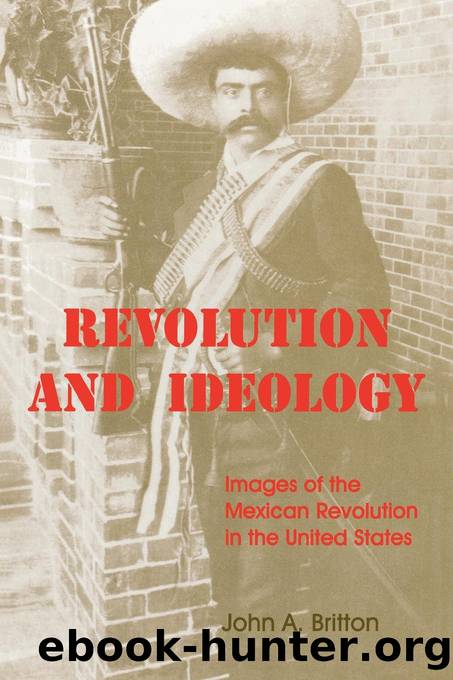Revolution and Ideology by Britton John A.;

Author:Britton, John A.; [Britton, John A.]
Language: eng
Format: epub
Publisher: University Press of Kentucky
Published: 2021-02-15T00:00:00+00:00
The Mainstream Press
The immediate economic turmoil resulting from the expropriations largely escaped the enthusiastic supporters of the Cárdenas program. With their eyes turned toward the ideals of social justice, these leftists seemed to believe that the dislocations, shortages, inflation, and general confusion associated with the land and oil expropriations were short-run phenomena that would eventually disappear.39
The leftist writers who presented an image of Mexico as a socialist state in the makingâa state populated with Marxists, an occasional Communist, and a potpourri of left-wingersâsought to stimulate acceptance, not revulsion and fear, in their reader. They received welcome but probably unexpected support in the pages of mass circulation publications. In the late 1930s, leftist ideas found legitimacy if not popularity in the United States. The continuing severity of the business collapse, the eclectic experimentation of the Roosevelt administration, and the ascent of leftist cultural values in the United States gave discussions of Mexican communal agriculture, socialist education, and government management of large sectors of the economy a familiar and even receptive context. In a general sense, Roosevelt and Cárdenas seemed bound in the same direction, although they had started from different locations on the scale of socioeconomic development. In 1938 Cárdenas apparently thrust his countryâs underdeveloped economy several steps ahead of the New Deal in the regulation and, in some cases, socialization of critical elements of production. Mexico obviously lagged far behind the United States in per capita industrial and agricultural output, but in the 1930s, announced intentions and symbolic actions carried much weight in politics and in public opinion.40
John Gunther, the roving journalist who specialized in quick studies of large and complex regions of the world for a popular readership, visited Mexico in 1941âafter Avila Camacho was in officeâto find the radical impetus of the Cárdenas administration still very much in evidence. Gunther accepted the idea that Cárdenas has âattempted to fulfill the social promises of the revolution.â The result was not a complete revamping of Mexicoâs distribution of wealth and power, but in Guntherâs words the former president had âmade a prodigious effort.â The journalist singled out Mexico in his 18,938-mile tour of the lands south of the Rio Grande as âthe only country in Latin America with an advanced social-economic program, with definite collectivist aims, principles, and accomplishments.â41 He specified Article 27 of the Constitution of 1917 as the basis for Mexicoâs collectivist orientation and in low-keyed tones described the land reform program and the oil expropriation as typical policies arising from such a leftist approach.42
Betty Kirk agreed with much of Guntherâs commentary, but in Covering the Mexican Front she provided a deeper political analysis and used the crucial word that Gunther seemed to avoid: âsocialism.â Kirk was an experienced journalist who came to Mexico in 1936 and, unlike Gunther, remained there for most of the next half-decade. She arrived with no obvious political commitments and an apparent but circumspect liberal statist ideology. She wrote regularly for the Christian Science Monitor and occasionally for the New York Times and Life magazines.
Download
This site does not store any files on its server. We only index and link to content provided by other sites. Please contact the content providers to delete copyright contents if any and email us, we'll remove relevant links or contents immediately.
| Africa | Americas |
| Arctic & Antarctica | Asia |
| Australia & Oceania | Europe |
| Middle East | Russia |
| United States | World |
| Ancient Civilizations | Military |
| Historical Study & Educational Resources |
Machine Learning at Scale with H2O by Gregory Keys | David Whiting(4183)
Never by Ken Follett(3791)
Fairy Tale by Stephen King(3220)
The Man Who Died Twice by Richard Osman(2997)
Oathbringer (The Stormlight Archive, Book 3) by Brandon Sanderson(2881)
Will by Will Smith(2793)
Rationality by Steven Pinker(2291)
The Dark Hours by Michael Connelly(2243)
Can't Hurt Me: Master Your Mind and Defy the Odds - Clean Edition by David Goggins(2228)
The Dawn of Everything: A New History of Humanity by David Graeber & David Wengrow(2122)
Friends, Lovers, and the Big Terrible Thing by Matthew Perry(2119)
Principles for Dealing With the Changing World Order: Why Nations Succeed and Fail by Ray Dalio(1974)
HBR's 10 Must Reads 2022 by Harvard Business Review(1777)
A Short History of War by Jeremy Black(1762)
Go Tell the Bees That I Am Gone by Diana Gabaldon(1687)
515945210 by Unknown(1599)
A Game of Thrones (The Illustrated Edition) by George R. R. Martin(1589)
Kingdom of Ash by Maas Sarah J(1526)
443319537 by Unknown(1470)
